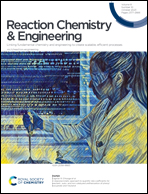Efficient neural network models of chemical kinetics using a latent asinh rate transformation†
Abstract
We propose a new modeling strategy to build efficient neural network representations of chemical kinetics. Instead of fitting the logarithm of rates, we embed the hyperbolic sine function into neural networks and fit the actual rates. We demonstrate this approach on two detailed surface mechanisms: the preferential oxidation of CO in the presence of H2 and the ammonia oxidation under industrially relevant conditions of the Ostwald process. Implementing the surrogate models into reactor simulations shows accurate results with a speed-up of 100 000. Overall, the approach proposed in this work will significantly facilitate the application of detailed mechanistic knowledge to the simulation-based design of realistic catalytic systems. We foresee that combining this approach with neural ordinary differential equations will allow building machine learning representations of chemical kinetics directly from experimental data.



 Please wait while we load your content...
Please wait while we load your content...